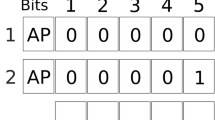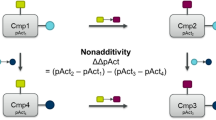Abstract
Publicly available screening data were systematically searched for extensively assayed structural analogs with large differences in the number of targets they were active against. Screening compounds with potential chemical liabilities that may give rise to assay artifacts were identified and excluded from the analysis. “Promiscuity cliffs” were frequently identified, defined here as pairs of structural analogs with a difference of at least 20 target annotations across all assays they were tested in. New assay indices were introduced to prioritize cliffs formed by screening compounds that were extensively tested in comparably large numbers of assays including many shared assays. In these cases, large differences in promiscuity degrees were not attributable to differences in assay frequency and/or lack of assay overlap. Such analog pairs have high priority for further exploring molecular origins of multi-target activities. Therefore, these promiscuity cliffs and associated target annotations are made freely available. The corresponding analogs often represent equally puzzling and interesting examples of structure-promiscuity relationships.







Similar content being viewed by others
References
Johnson M, Maggiora GM, editors. Concepts and applications of molecular similarity. John Wiley & Sons: New York; 1990.
Wassermann AM, Wawer M, Bajorath J. Activity landscape representations for structure-activity relationship analysis. J Med Chem. 2010;53(23):8209–23. doi:10.1021/jm100933w.
Stumpfe D, Hu Y, Dimova D, Bajorath J. Recent progress in understanding activity cliffs and their utility in medicinal chemistry. J Med Chem. 2014;57(1):18–28. doi:10.1021/jm401120g.
Bredel M, Jacoby E. Chemogenomics: an emerging strategy for rapid target and drug discovery. Nat Rev Genet. 2004;5(4):262–75. doi:10.1038/nrg1317.
Hu Y, Bajorath J. Compound promiscuity—what can we learn from current data. Drug Discov Today. 2013;18(13–14):644–50. doi:10.1016/j.drudis.2013.03.002.
Hu Y, Bajorath J. High-resolution view of compound promiscuity. F1000Research. 2013;2:144. doi:10.12688/f1000research.2-144.v2.
Paolini GV, Shapland RH, van Hoorn WP, Mason JS, Hopkins AL. Global mapping of pharmacological space. Nat Biotechnol. 2006;24(7):805–15. doi:10.1038/nbt1228.
Boran AD, Iyengar R. Systems approaches to polypharmacology and drug discovery. Curr Opin Drug Discov Devel. 2010;13(3):297–309.
Roukos DH. Network medicine: from reductionism to evidence of complex biomolecular interactions. Pharmacogenomics. 2011;12(5):695–8. doi:10.2217/pgs.11.28.
Nurse P. Reductionism: the ends of understanding. Nature. 1997;387(6634):657.
Bruns RF, Watson IA. Rules for identifying potentially reactive or promiscuous compounds. J Med Chem. 2012;55(22):9763–72. doi:10.1021/jm301008n.
Baell JB, Holloway GA. New substructure filters for removal of pan assay interference compounds (PAINS) from screening libraries and for their exclusion in bioassays. J Med Chem. 2010;53(7):2719–40. doi:10.1021/jm901137j.
Baell J, Walters MA. Chemical con artists foil drug discovery. Nature. 2014;513(7519):481–3. doi:10.1038/513481a.
McGovern SL, Caselli E, Grigorieff NA. Common mechanism underlying promiscuous inhibitors from virtual and high-throughput screening. J Med Chem. 1996;45(8):1712–22. doi:10.1021/jm010533y.
Shoichet BK. Screening in a spirit haunted world. Drug Discov Today. 2006;11(13–14):607–15. doi:10.1016/j.drudis.2006.05.014.
Dimova D, Hu Y, Bajorath J. Matched molecular pair analysis of small molecule microarray data identified promiscuity cliffs and identifies molecular origins of extreme compound promiscuity. J Med Chem. 2012;55(22):10220–8. doi:10.1021/jm301292a.
Dimova D, Gilberg E, Bajorath J. Identification and analysis of promiscuity cliffs formed by bioactive compounds and experimental implications. RSC Adv. 2017;7:58–66. doi:10.1039/C6RA27247A.
Bento AP, Gaulton A, Hersey A, Bellis LJ, Chambers J, Davies M, Krüger FA, Light Y, Mak L, McGlinchey S, Nowotka M, Papadatos G, Santos R, Overington JP. The ChEMBL bioactivity database: an update. Nucleic Acids Res. 2014;42(Database issue):D1083–90. doi:10.1093/nar/gkt1031.
Wang Y, Xiao J, Suzek TO, Zhang J, Wang J, Zhou Z, Han L, Karapetyan K, Dracheva S, Shoemaker BA, Bolton E, Gindulyte A, Bryant SH. PubChem’s BioAssay database. Nucleic Acids Res. 2012;40(Database issue):D400–12. doi:10.1093/nar/gkr1132.
Jasial S, Hu Y, Bajorath J. Determining the degree of promiscuity of extensively assayed compounds. PLoS One. 2016;11(4):e0153873. doi:10.1371/journal.pone.0153873.
Griffen E, Leach AG, Robb GR, Warner DJ. Matched molecular pairs as a medicinal chemistry tool. J Med Chem. 2011;54(22):7739–50. doi:10.1021/jm200452d.
Hussain J, Rea C. Computationally efficient algorithm to identify matched molecular pairs (MMPs) in large data sets. J Chem Inf Model. 2010;50(3):339–48. doi:10.1021/ci900450m.
Hu X, Hu Y, Vogt M, Stumpfe D, Bajorath J. MMP-cliffs: systematic identification of activity cliffs on the basis of matched molecular pairs. J Chem Inf Model. 2012;52(5):1138–45. doi:10.1021/ci3001138.
OEChem, version 1.7.7, OpenEye Scientific Software, Inc., Santa Fe, NM, USA. 2012.
RDKit, Cheminformatics and Machine Learning Software, 2013. http://www.rdkit.org.
Sterling T, Irwin JJ. ZINC 15—ligand discovery for everyone. J Chem Inf Model. 2015;55(11):2324–37. doi:10.1021/acs.jcim.5b00559.
Lagorce D, Sperandio O, Baell JB, Miteva MA, Villoutreix BO. FAF-Drugs3: a web server for compound property calculation and chemical library design. Nucleic Acids Res. 2015;43(W1):W200–7. doi:10.1093/nar/gkv353.
Irwin JJ, Duan D, Torosyan H, Doak AK, Ziebart KT, Sterling T, Tumanian G, Shoichet BK. An aggregation advisor for ligand discovery. J Med Chem. 2015;58(17):7076–87. doi:10.1021/acs.jmedchem.5b01105.
Willett P, Barnard J, Downs GM. Chemical similarity searching. J Chem Inf Comput Sci. 1998;38(6):983–96. doi:10.1021/ci9800211.
UniProtConsortium. The universal protein resource (UniProt) in 2010. Nucleic Acids Res. 2010;38(Database issue):D142–8. doi:10.1093/nar/gkp846.
Müller G. Medicinal chemistry of target family-directed masterkeys. Drug Discov Today. 2003;8(15):681–91. doi:10.1016/S1359-6446(03)02781-8.
Hu Y, Jasial S, Gilberg E, Bajorath J. High-priority promiscuity cliffs from PubChem. Zenodo. 2017. doi:10.5281/zenodo.321285.
Wassermann AM, Bajorath J. Chemical substitutions that introduce activity cliffs across different compound classes and biological targets. J Chem Inf Model. 2010;50(7):1248–56. doi:10.1021/ci1001845.
Acknowledgements
We thank OpenEye Scientific Software, Inc. for a free academic license of the OpenEye Toolkits.
Author information
Authors and Affiliations
Corresponding author
Electronic supplementary material
ESM 1
(DOC 104 kb)
Rights and permissions
About this article
Cite this article
Hu, Y., Jasial, S., Gilberg, E. et al. Structure-Promiscuity Relationship Puzzles—Extensively Assayed Analogs with Large Differences in Target Annotations. AAPS J 19, 856–864 (2017). https://doi.org/10.1208/s12248-017-0066-8
Received:
Accepted:
Published:
Issue Date:
DOI: https://doi.org/10.1208/s12248-017-0066-8




